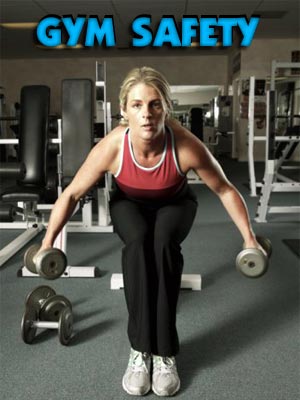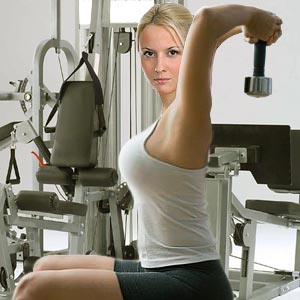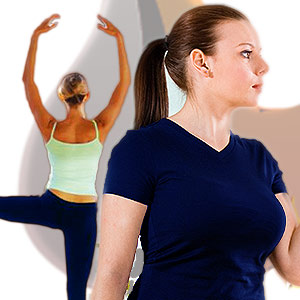TargetWoman - Portal for Women
Gym Safety Tips
TargetWoman is a portal dedicated to Women - Pages of lasting value on issues women care about.

Pick a few vital tips to maintain gym safety. Use equipment correctly and watch out for any symptoms of distress or discomfort.
It is essential to follow certain safety tips while you are out at your fitness center. This will assure your safety during workouts while avoiding injuries and/or other complications. It is imperative that you adhere to your physician's/fitness therapist's guidelines before taking up any workouts. Check out vital gym safety tips.
Gym safety
- Check your fitness before you start up any strength-training program. You might have to modify or avoid weightlifting if you have muscle or joint problems, seizure disorders, heart disease, high blood pressure, previous injuries or any other physical condition with potential for danger.
- One of the cardinal principles of gym safety is to never work out when you are tired or ill. You can worsen your situation or injure yourself.
- Warm up before any aerobic workout, as it involves repetitive exercise that increases your heart rate. Stretch your muscles before putting them through a strenuous workout. Follow your brief warm-up with some stretches. Do not injure your muscles without preparing them adequately.
- Don't rush into any sport or exercise without warming up first - muscles that haven't been properly prepared tend to be injured more easily. Start out with some light cardiovascular activities, such as easy jogging, jumping jacks, or brisk walking, just to get your muscles going.
- Do not lift weights jerkily. This can lead to muscle injuries. Do your exercises in a slow and controlled manner. Increase weights gradually. Use safety collars when working out on squats, bench presses, curls and dumbbells. This will ensure that weight plates don't slip off and cause an injury. Use a weight belt, wraps, straps and gloves to support heavy lifts. This protects your lumbar region. Knee wraps prevent injury to your tendons and ligaments.
- Using the proper lifting form is important not only to work your muscles correctly, but also to prevent injury. Always do your exercises through a full range of motion in a slow, controlled manner.
- Don't hold your breath while lifting weights, it can cause inter-abdominal pressure that can lead to hernia. Breathe out as you exert yourself and breathe in as you relax and let weight back down. Repeat exercise routines steadily to benefit from the workout. Lift weights with control and not explosively.
- Don't lean heavily on the stair-stepper rails. Leaning heavily on the stair-stepper rails will place unnecessary weight on your wrists and back. Unnecessary leaning can cause injuries to your wrists and back.
- Drink water while you workout. This prevents dehydration and aids better workout performance. Stop your gym activity if you experience dizziness, fainting or change in heart rhythm. Any significant increase or drop in blood pressure must not be ignored. A critical gym safety tip is to discontinue the fitness activity if you feel tightness in the chest or shoulders and surrounding areas.
- Replace gym equipment in the right place after you are done with them. Leaving them around can injure other gym members. Always use the collars that prevent weights from falling off the barbells. Keep your hands away from chains, cams, pulleys, and weight plates of exercise machines when they are in use. Use gym equipment after wiping them. Wash your hands after your workout. This may reduce your chance of catching any virus.
Top of the Page: Gym Safety Tips
Tags:#gym safety #gym safety tips
More on Women's Diet and Fitness

Posture Correction
Qigong Exercises
Five Tibetan Rites
Piloxing Workout
Calisthenics
Karate For Women
Self Defense for Women
Krav Maga
Circuit Training
Interval Training
Hybrid Workouts
Barre Workout
Eskrima Workout
Learn Tai Chi
Indoor Rock Climbing
Reducing Body Fat Percentage
Fat Burning Zone
PACE Progressively Accelerating Cardiopulmonary Exertion
Non-exercise Activity Thermogenesis
Women Fitness
Morning Exercise and Metabolism
Choosing Fitness Center
Fitness Center for Women
Fitness Weight Loss in women
Home Fitness Equipment
Kid Fitness
Gym Safety Tips
Building Lean Muscle
Lose Belly Fat
Flat Belly Tips
Exercises for Women
Toned Arms for Females
Hip Flexor Strengthening
How to lose Muffin Top
Plyometric Exercises
Flexibility Exercise Program
Belly Bloat
Body Sculpting Exercises
Core Strengthening Exercises
Core Strengthening Benefits
Exercise for Seniors
Fitness Exercise Articles
Anti Aging Exercise
Rebounder Exercise
Jogging Exercise
Flat Stomach Exercise
Knee Exercise
Butt Exercise
Weight Exercises for Women
Chest Exercise for Women
Stretching Exercise
Lower Back Exercise
Hip Exercises
Leg Exercise
Abdominal Exercise
Face Workout
Face Exercises Benefits
Double Chin Exercise
Eye Exercise Benefit
Thigh Exercises
Stair Climbing Exercise
Isometric Exercise
Pilates Exercise
Magic Circle Exercises
Rotator Cuff Exercises
Arm Exercise
Kegel Exercises for Women
Carpal Tunnel Exercises
Exercise Equipment
Xiser Workout
Foam Rolling Exercises
Rowing Exercise Machine
Elliptical Machine Benefits
Stepper Exercise Machine
Dumbbell Exercise
Weight Loss Calculator
Strapless Heart Rate Monitor
Home Exercise Equipment
Recumbent Exercise Bike
Resistance Exercise Band
Weight Lifting Exercise
Ball Exercise
Kettlebell Exercises
Medicine Ball Exercises
Swiss Exercise Ball
Kamagon Ball Workouts

Posture Correction
Qigong Exercises
Five Tibetan Rites
Piloxing Workout
Calisthenics
Karate For Women
Self Defense for Women
Krav Maga
Circuit Training
Interval Training
Hybrid Workouts
Barre Workout
Eskrima Workout
Learn Tai Chi
Indoor Rock Climbing
Reducing Body Fat Percentage
Fat Burning Zone
PACE Progressively Accelerating Cardiopulmonary Exertion
Non-exercise Activity Thermogenesis
Women Fitness
Morning Exercise and Metabolism
Choosing Fitness Center
Fitness Center for Women
Fitness Weight Loss in women
Home Fitness Equipment
Kid Fitness
Gym Safety Tips
Building Lean Muscle
Lose Belly Fat
Flat Belly Tips
Exercises for Women

Toned Arms for Females
Hip Flexor Strengthening
How to lose Muffin Top
Plyometric Exercises
Flexibility Exercise Program
Belly Bloat
Body Sculpting Exercises
Core Strengthening Exercises
Core Strengthening Benefits
Exercise for Seniors
Fitness Exercise Articles
Anti Aging Exercise
Rebounder Exercise
Jogging Exercise
Flat Stomach Exercise
Knee Exercise
Butt Exercise
Weight Exercises for Women
Chest Exercise for Women
Stretching Exercise
Lower Back Exercise
Hip Exercises
Leg Exercise
Abdominal Exercise
Face Workout
Face Exercises Benefits
Double Chin Exercise
Eye Exercise Benefit
Thigh Exercises
Stair Climbing Exercise
Isometric Exercise
Pilates Exercise
Magic Circle Exercises
Rotator Cuff Exercises
Arm Exercise
Kegel Exercises for Women
Carpal Tunnel Exercises
Exercise Equipment
Xiser Workout
Foam Rolling Exercises
Rowing Exercise Machine
Elliptical Machine Benefits
Stepper Exercise Machine
Dumbbell Exercise
Weight Loss Calculator
Strapless Heart Rate Monitor
Home Exercise Equipment
Recumbent Exercise Bike
Resistance Exercise Band
Weight Lifting Exercise
Ball Exercise
Kettlebell Exercises
Medicine Ball Exercises
Swiss Exercise Ball
Kamagon Ball Workouts
Top of the Page: Gym Safety Tips
Popularity Index: 100,974

